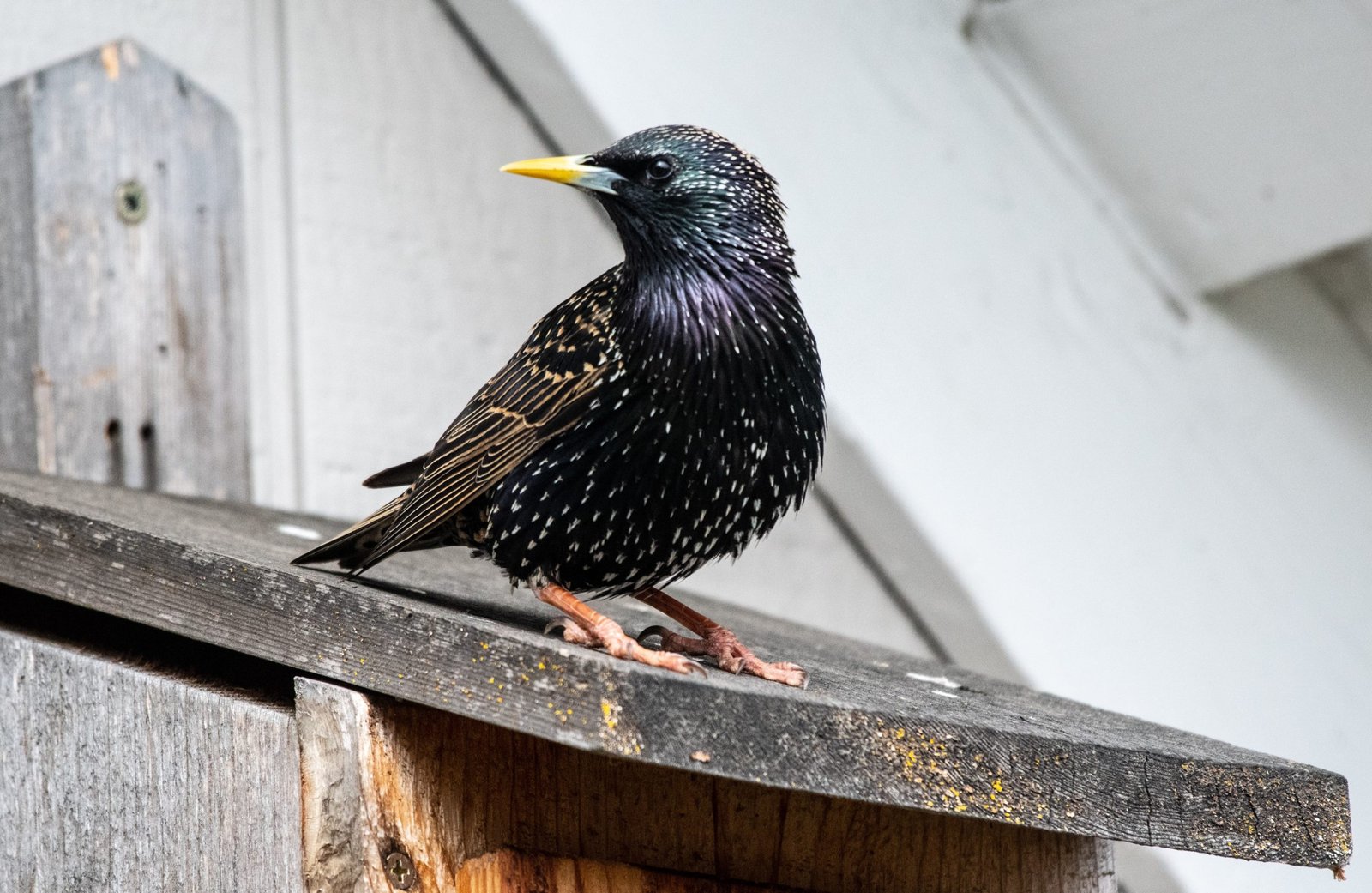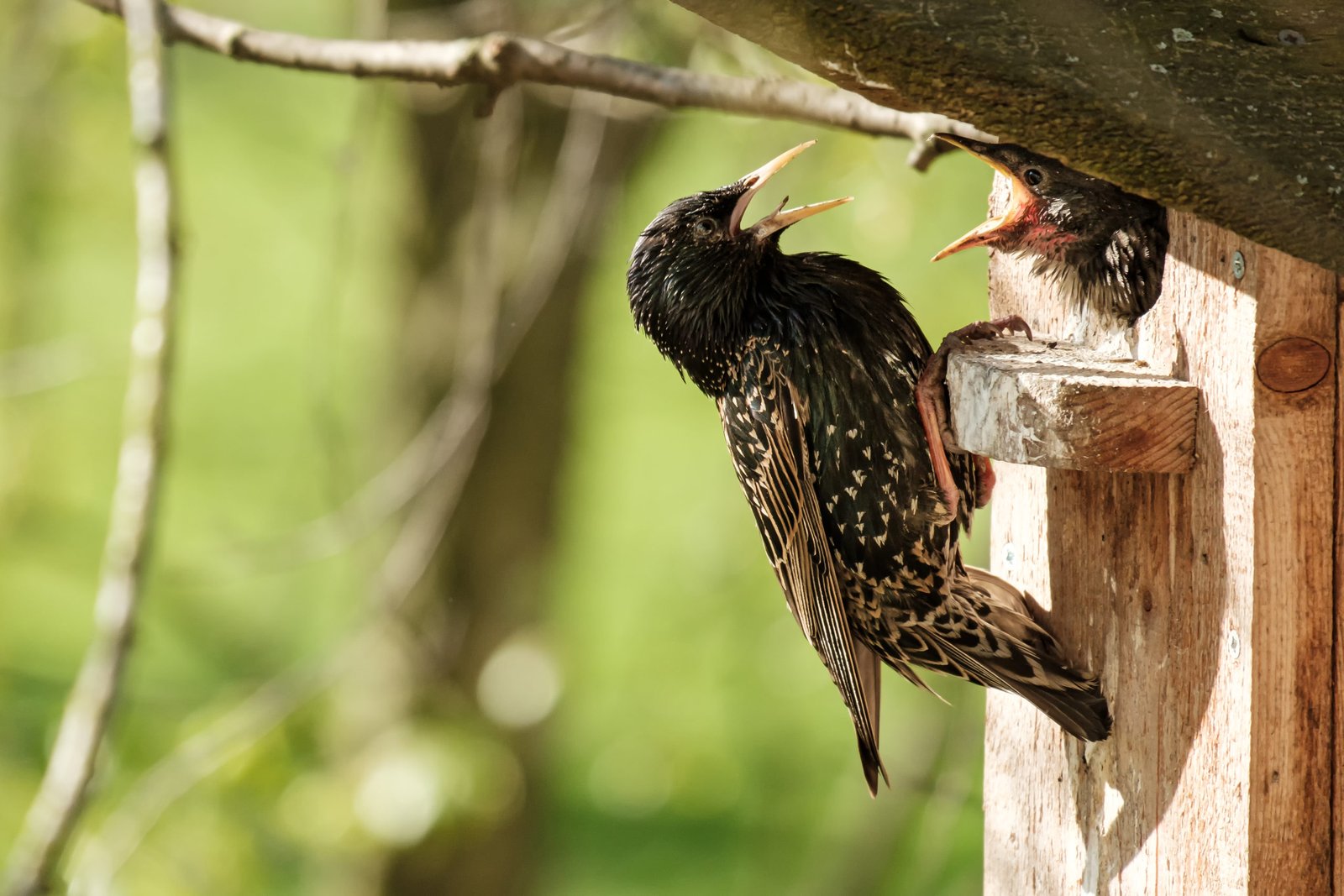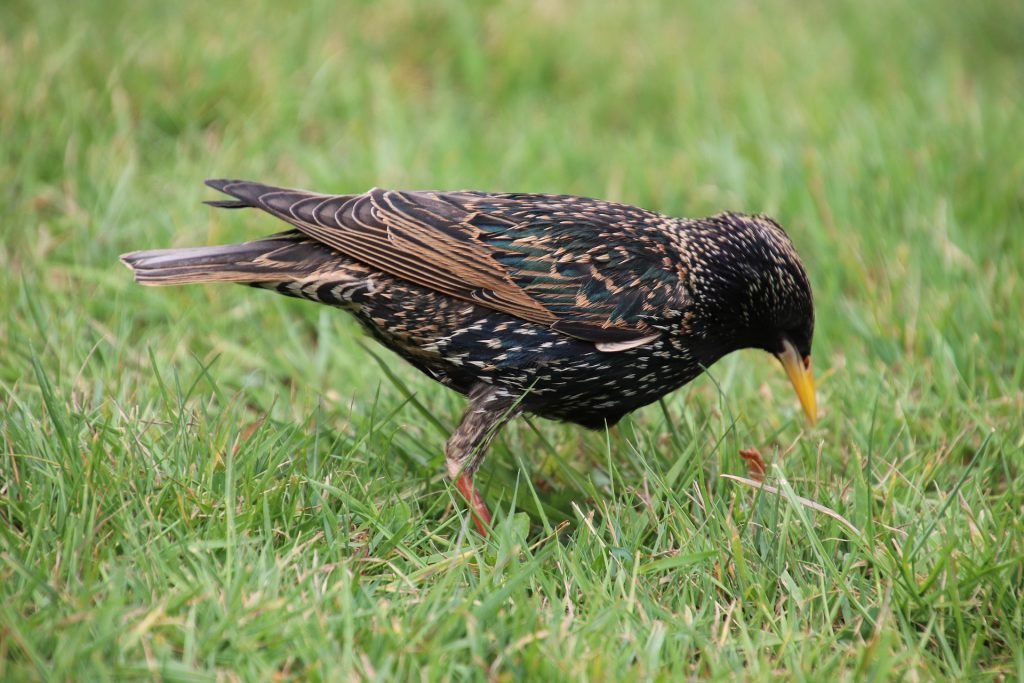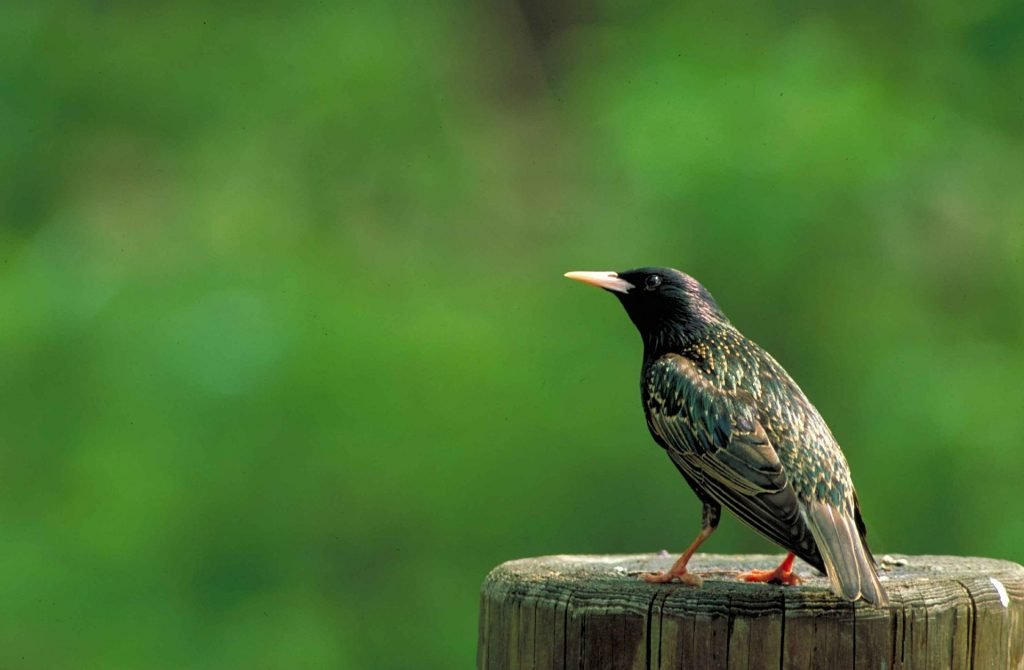European Starlings: Sturnus Vulgaris

Description Of The European Starling
The European starling is a small black bird with iridescent green and purple feathers. The cream-colored tips of the feathers create a distinctive “flecking” effect. These pale tips erode away in the winter, revealing the breeding male’s deep purple gloss on the nape, cheeks, and throat.
The male develops elongated breeding plumage on his breast during the winter—the color of his back, flanks, and rump changes to a deep iridescent green. The male’s breeding plumage is fully developed by the summer. The female starling does not have a breeding plumage, less colorful, and has more cream-colored flecks than the male.
Both sexes have deep pink or reddish colored legs. Juveniles are brown in color with a paler belly and a brown bill, and during the transition from juvenile to adult plumage, they have a period of variable feather color.
Male and female starlings are about 20-22 cm in length and weigh 70-100 grams. Starlings have a short square tail and triangular wings when flying. 1Go To Source columbia.edu -“European Starling (Sturnus vulgaris)”
Learn More: Common Pest Bird Species
European Starling Behavior

“Secondary cavity nesters” are European starlings. This means they need to nest in natural or human-made cavities. They are out-competing native North American birds that use cavities as nesting sites because they are aggressive, and their population is growing. Some wren, swallow, and bluebird populations have suffered as a result of this.
European starlings use grasses, twigs, and moss to build their nests. Fresh leaves are used to line them. The birds replace these leaves regularly, and they may have antibiotic or antifungal properties.
European starlings are gregarious birds who constantly congregate with other starlings. These birds breed in large flocks, feed in large flocks, and migrate in large groups. Starlings are not only social, but they are also tolerant of human disturbance. 2Go To Source biokids.umich.edu -“European starling Sturnus vulgaris”
Nesting Habits Of The European Starling
Males select the nesting location and use it to entice females. The nests are almost always found in a cavity, which can be found in a building or other structure (look for them in streetlights and traffic signal supports), an old woodpecker hole, or a nest box. Starlings also build their nests in burrows and cliffs on occasion. The average height of a nest hole is 10 to 25 feet off the ground, but it can reach 60 feet.
European Starling Reproduction Cycle
In most cases, the breeding season begins in the spring and ends in the early summer. The breeding season varies in length from year to year. Starlings typically go through three phases of breeding, resulting in a clutch of eggs. The first clutch, which contains about five eggs, is usually timed to coincide with other starlings laying eggs in the area. The starlings’ polygynous behavior results in the second or “intermediate clutch” of eggs. The third clutch, which is not as well-synchronized as the first, usually arrives forty to fifty days later.
The eggs of starlings are primarily glossy light blue and white. The incubation period for the eggs is eleven days on average. Females incubate the eggs for the majority of the time because their incubation patches are more developed. Starlings can multiply and invade quickly due to their high fertility, polygyny, and ability to consume a wide range of foods and habitats. 3Go To Source animaldiversity.org -“Sturnus vulgaris common starling (Also: European starling)”
Diet Of European Starlings

This bird species mostly forages on the ground in open areas, probing the soil with its bill. Occasionally it eats the fruit from trees and catches flying insects in the air. Foraging activity typically occurs in flocks.
Insects, berries, and seeds are the most common. The diet is quite diverse. When available, it eats insects, such as beetles, grasshoppers, flies, caterpillars, spiders, snails, earthworms, and other invertebrates primarily. This bird will also eat a wide variety of berries, fruits, and seeds, especially in the fall and winter. Flowers are visited for nectar on occasion. Bird feeders also provide an easy meal for the European starling.
European Starling Prefered Habitat
This bird can be found in urban, suburban, and rural areas during the summer. They eat from the ground as well as from birdfeeders. They frequently migrate to rural areas in the spring to nest in woodpecker holes or other cavities in trees and buildings.
During the summer and fall, young birds congregate in flocks known as creches, which may include grackles and blackbirds. Hundreds of thousands of European starlings could be swarming high in the sky over cities and farmland in large swirling creches. 4Go To Source nature.mdc.mo.gov -“EUROPEAN STARLING Sturnus vulgaris”
Range & Distribution Of European Starlings
From the Atlantic to the Pacific and central Canada to northern Mexico, the European Starling can be found in North America. In 1890, European starlings were introduced to the United States for the first time. According to legend, one hundred starlings were released in Central Park in the hopes of establishing all of the birds from Shakespeare’s works in the New World. The wish came true in the case of the starling. In the last century, the starling population has swelled to between 150 and 200 million birds.
European Starlings have been deliberately introduced throughout the world, primarily for aesthetic reasons. Starlings, ironically, are now widely regarded as pests for various reasons, including their large flocks, noisy habits, and copious waste, all of which are considered aesthetically unappealing. Some claim that insect pests’ biological control was a factor in the release of starlings, but studies have shown that they are not as effective as hoped.
European Starlings As Pests
The European Starling is known as a pest for several reasons: it outcompetes native birds like bluebirds and woodpeckers, stealing their nesting cavities and destroying their eggs and young; it is aggressive at feeders, keeping smaller birds away and eating large amounts of birdseed; its massive winter foraging flocks damage agricultural crops, and large flocks leave large amounts of droppings. 5Go To Source maine.gov -“Starlings, Crows and Sparrows”
Damaged Caused By European Starlings

- Starling nests frequently clog gutters and drainage pipes, causing extensive water damage.
- Starlings love to nest in exhaust vents and ductwork, leading to poor indoor air quality and fire hazards.
- The uric acid in European Starling feces can damage paint, plastic, canvas canopies, and other materials. A large buildup of feces from these flocks can cause structural damage causing stone, metal, and masonry to corrode.
- Because flocks of starlings eat high-protein supplements added to livestock feed and spread viruses between livestock facilities, starlings can be costly to cattle and swine producers.
- The accumulation of starling feces creates a falling/slipping hazard.
European Starling Trapping Strategies
Trapping can be a good way to keep starlings under control, especially if done over a large area like several orchards. The modified Australian crow trap is the most effective trap for these species.
The behavior patterns of the birds must be taken into account when trapping them. To attract more birds, these traps use live birds as decoys. To keep the trapped birds alive, traps are set in suitable locations with enough food, water, shade, and roosting areas.
Trapping is best done by someone who is familiar with the technique, such as a trained wildlife removal technician.
The use of a CO2 chamber is commonly used to euthanize trapped birds. A few birds may be kept alive to use as decoys in the future. 6Go To Source ipm.ucanr.edu -“European Starling Sturnus vulgaris”
Removal Of European Starlings
A licensed pest control professional should conduct a site survey, including the location of the problem, bird species observed, habitat recommended control procedures, and pricing considerations to get rid of European starlings.
Before addressing the issue, it is necessary to review relevant federal, state, and local regulations. The federal endangered species act and migratory bird statutes do not protect starlings, but some states may do so. Local permits are also required if the area is a bird sanctuary. After this has been determined, the licensed pest control professional can recommend a removal plan.
Sources:
- Marion Adeney, Jennifer. “Invasion Biology Introduced Species Summary Project – Columbia University.” Columbia University In The City Of New York, Columbia University, 18 Oct. 2001, www.columbia.edu/itc/cerc/danoff-burg/invasion_bio/inv_spp_summ/Sturnus_vulgaris.html.
- Chow, J. 2000. “Sturnus vulgaris” (On-line), Animal Diversity Web. Accessed March 08, 2021 at http://www.biokids.umich.edu/accounts/Sturnus_vulgaris/
- Chow, J. 2000. “Sturnus vulgaris” (On-line), Animal Diversity Web. Accessed March 08, 2021 at https://animaldiversity.org/accounts/Sturnus_vulgaris/
- Missouri Department Of Conservation. “European Starling.” MDC Discover Nature, State Of Missouri, nature.mdc.mo.gov/discover-nature/field-guide/european-starling. Accessed 8 Mar. 2021.
- Maine Department of Agriculture, Conservation and Forestry. “Starlings, Crows and Sparrows.” Maine.Gov, www.maine.gov/dacf/php/gotpests/othercritters/starlings.htm#:%7E:text=The%20European%20Starling%20is%20considered,birdseed%3B%20its%20enormous%20winter%20foraging. Accessed 8 Mar. 2021.
- Baldwin, R. A. “European Starling / Citrus / Agriculture: Pest Management Guidelines / UC Statewide IPM Program (UC IPM).” University Of California Agriculture & Natural Resources, University Of California, July 2016, www2.ipm.ucanr.edu/agriculture/citrus/European-Starling.
